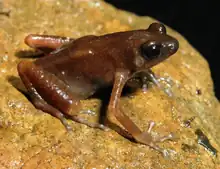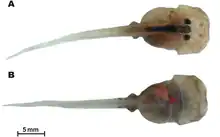| Siamophryne | |
|---|---|
 | |
| A male Siamophryne troglodytes | |
| Scientific classification | |
| Domain: | Eukaryota |
| Kingdom: | Animalia |
| Phylum: | Chordata |
| Class: | Amphibia |
| Order: | Anura |
| Family: | Microhylidae |
| Subfamily: | Asterophryinae |
| Genus: | Siamophryne Suwannapoom, Sumontha, Tunprasert, Ruangsuwan, Pawangkhanant, Korost & Poyarkov, 2018 |
| Species: | S. troglodytes |
| Binomial name | |
| Siamophryne troglodytes Suwannapoom, Sumontha, Tunprasert, Ruangsuwan, Pawangkhanant, Korost & Poyarkov, 2018 | |

Siamophryne is a genus of frog found in Thailand. It is monotypic, consisting of only one species, the Tenasserim cave frog (Siamophryne troglodytes).[1] Its closest relative is the genus Vietnamophryne.
The genus Siamophryne was first described by Suwannapoom, et al. (2018).[2]
Ecology
S. troglodytes is known only from a single limestone cave system in Sai Yok District, Kanchanaburi Province, western Thailand. There are several species of guano-producing bats inhabiting the cave system. The ecology of the cave is affected by local guano mining.[2]
Evolutionary history
The basal positions of the genera Vietnamophryne and Siamophryne within the subfamily Asterophryinae point to the origin of the subfamily in Indochina, with dispersals into Australasia occurring subsequently.[2]
See also
- Tenasserim Hills, its namesake
References
- ↑ "Siamophryne". AmphibiaWeb. University of California, Berkeley. 2019. Retrieved 27 September 2019.
- 1 2 3 Suwannapoom C, Sumontha M, Tunprasert J, Ruangsuwan T, Pawangkhanant P, Korost DV, Poyarkov NA (2018). "A striking new genus and species of cave-dwelling frog (Amphibia: Anura: Microhylidae: Asterophryinae) from Thailand". PeerJ. 6: e4422. doi:10.7717/peerj.4422. PMC 5828679. PMID 29497587.